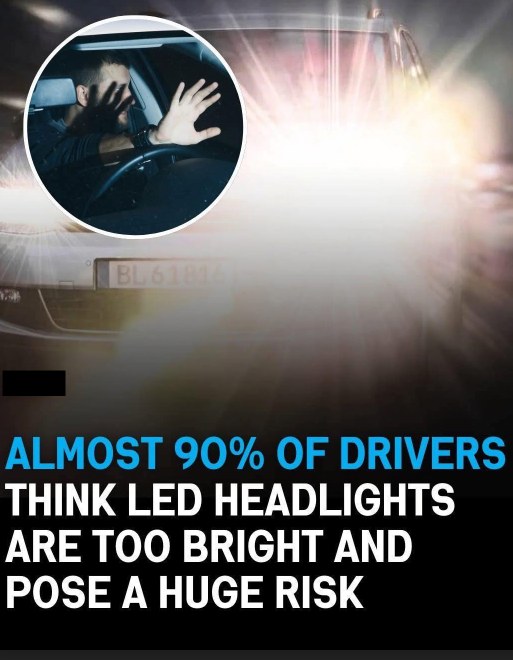In today’s car market, LED headlights have become the gold standard in vehicle design, favored for their sleek look, impressive energy efficiency, and long lifespan. Automakers proudly promote them as a smart innovation that boosts visibility and enhances the modern appearance of their vehicles.

However, despite all the praise, a growing number of drivers feel that this bright advancement may have gone a little too far. According to recent reports, nearly 90% of drivers believe that LED headlights are simply too bright and pose a serious hazard on the road. This widespread concern has sparked ongoing debates about how to strike the right balance between embracing new technology and ensuring public safety. Although LED headlights come with a list of advantages, their intense brightness has led to an unexpected downside—many drivers say the glare is not only uncomfortable but potentially dangerous.
One of the main complaints is that the powerful beams from LED lights can temporarily blind oncoming drivers, especially at night or in poor weather conditions. This sudden burst of brightness can cause drivers to squint, look away from the road, or momentarily lose sight of lane markings or obstacles. The result? A rise in near-misses, slowed reaction times, and heightened anxiety behind the wheel. The conversation around LED lights isn’t about dismissing progress—it’s about ensuring that innovation doesn’t come at the cost of safety. The shift from traditional halogen bulbs to LEDs has been swift and significant. Halogen bulbs, which have lit roads for decades, work by heating a filament to produce light, a method that wastes a lot of energy as heat.
LED lights, on the other hand, use semiconductor technology to convert electricity into light with minimal heat loss, making them far more efficient. They also last much longer, reducing the need for frequent replacements, and offer a sharp, focused beam that can light up the road more clearly for the driver. These features make LEDs an attractive option for manufacturers looking to improve energy usage and reduce long-term maintenance for car owners. On the surface, it’s easy to see why LEDs are considered a step forward. However, their brightness—especially when not properly aimed or regulated—can become overwhelming for other drivers sharing the road. The problem is especially common when newer cars with LED systems cross paths with older vehicles that lack advanced lighting controls or when headlight angles aren’t correctly adjusted.
The disparity between vehicle lighting systems has created an inconsistent and sometimes hazardous driving experience. Drivers on forums and social media have shared stories of nighttime drives made miserable by glaring headlights that felt more like stadium floodlights than car beams. Some have even admitted to avoiding night driving altogether out of fear of encountering another set of blinding LED headlights. This growing frustration is pushing regulatory agencies and safety advocates to take a closer look at current lighting standards. One potential solution is the broader adoption of adaptive lighting systems—technology that adjusts headlight brightness and direction automatically based on surrounding conditions and traffic. While this feature is available in some high-end models, it has yet to become standard across the board. Another approach is to enforce stricter guidelines on headlight alignment and brightness levels to ensure consistency and safety. Still, until these changes are implemented on a large scale, many drivers are left to deal with the reality of LED glare every time they hit the road after dark. It’s clear that while LED headlights offer many technical benefits, their impact on other drivers cannot be ignored. As automakers continue to innovate, it’s essential that they also prioritize the experience of everyone on the road—not just the person behind the wheel of the newest model. Technology should improve safety for all, and that includes making sure that the lights guiding one driver’s way don’t blind the rest. When nearly 90% of people express the same concern, it’s time to consider that brighter isn’t always better—it just might be too much.





